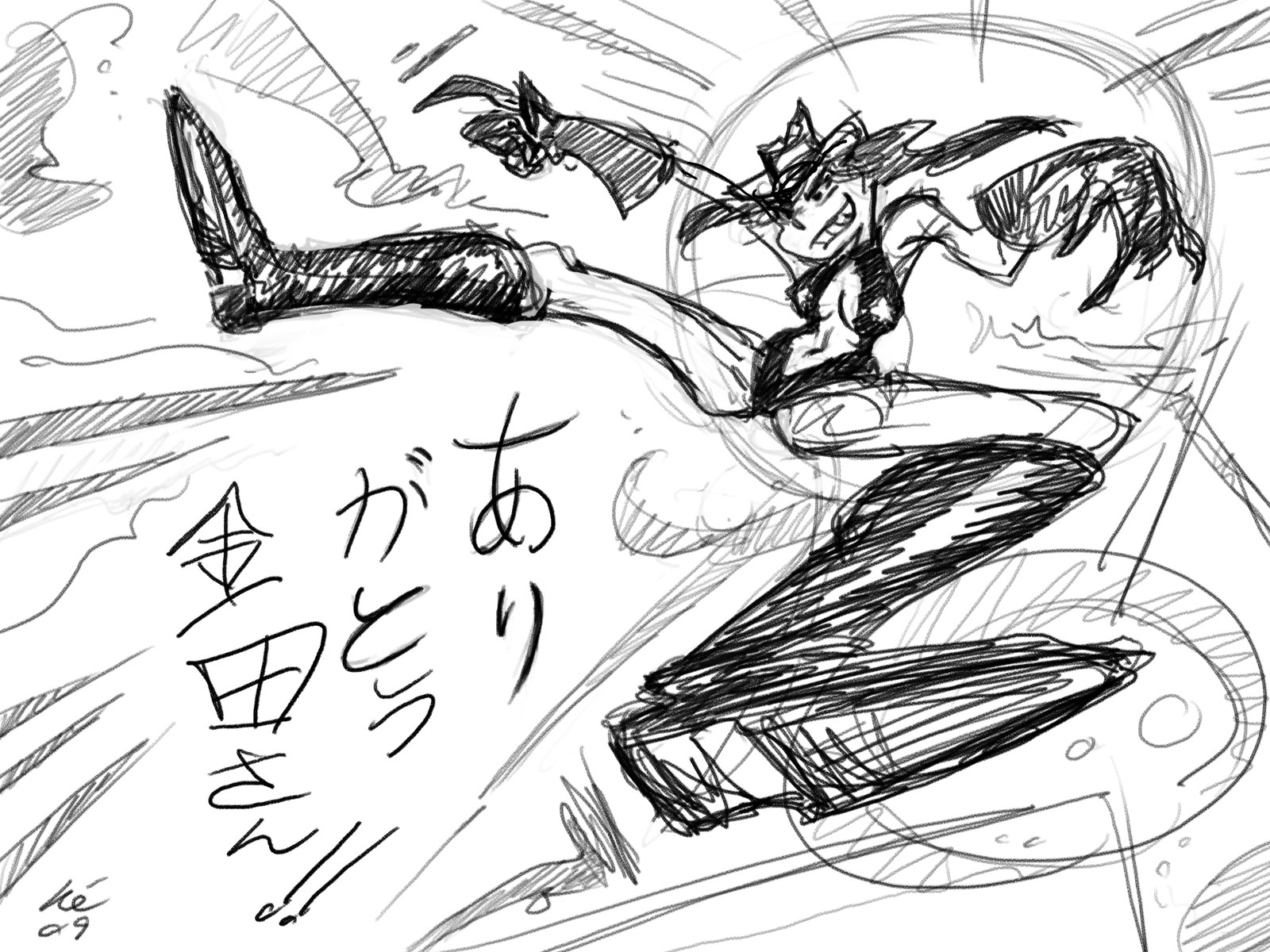ありがとう金田さん!!
It’s been a few months since his passing, and Yoshinori Kanada’s animation still influences me greatly. It’s a pity that I only really found out about his work in the last few years, but it obviously reached my sight and mind many years ago without my full awareness. But I guess art works in this transcendental way in which we tend to experience an artist’s work sometimes vicariously through another, or it just happens to exist in the world sometimes lasting generations, so ingrained in our culture, that it surpasses its original purpose. To many, Kanada’s animation is just that, and I’m very happy to have learned about his work, and I continuously keep searching for it.
It was in one Anipages article that his name first popped up to me. Ben Ettinger is of course an expert in the field of recognizing animators by their scenes, but he’s also a very astute animation critic. I had known of the work of Hiroyuki Imaishi years ago through my familiarity with FLCL (of which he directed ep 5) and I could write a whole other essay on him alone, but I’ll save that for later; the fact is Imaishi’s animation made me notice something that I had seen before. Not necessarily a style, but a feeling; a feeling of timing and life that can only be found in Japanese animation. My young inexperienced mind then couldn’t understand how one pose in one drawing could be followed by a completely different one in another, and yet, in real-time it just worked. But, that is just one aspect of what Ettinger calls the “Kanada School” of animation.
Since Ben has written about it in a much more eloquent way then I ever could, I’ll leave it up to you to check the links to his articles – they are all very well written and translated (for instance this article translation of Hayao Miyazaki writing about Yoshinori Kanada.) However, what I can say in this modest post are my personal feelings and why Kanada’s animation affects me so much. The “thank you” drawing above certainly encapsulates a lot of my feelings on his artwork, and while I did it very fast and without over thinking too much, that is what I think must have gone through Kanada’s mind when animating. The poses and expressions just seem so free, like quick gesture drawings that flow on the page without the artist even looking. His figures move in a rather syncopated way, with such impeccable timing that almost feels like he’s improvising animation in real-time, giving it a sense of spontaneity to a very premeditated medium (and I’m paraphrasing Peter Chnug here – he’s written an article on AWN about spontaneity an animation years ago.) That freedom that he gives his characters makes it almost feel like the characters themselves aren’t just alive, but want to be alive in a “Kanada World” so to speak. It’s like they have to move that way to get the most out of their inner most feelings, as if nothing but that pose and that timing cannot describe their emotions. And of course, that also translates to the camera and effects work. Kanada constantly played with the sense of camera in his works, creating something truly original and something very unique about hand drawn animation. Moving the camera the way he does in any other medium will just look bad, or a mistake, but somehow (again) when he does it, it just works. That is partly because he’s not merely moving the camera in extreme quirky ways, but he lets the emotion of the scene or the character guide the timing and movement, simultaneously, further emphasizing that sense of spontaneity. You don’t even notice the quick camera zooms because the characters often dictate the camera, and let you experience the motions through their emotions. And the effects follow that philosophy as well in abstract shapes of light or smoke that often look like neither, but when timed just right, heighten that sense of reality in the drawings. (His “punch takes” or lightning frames are beautiful works of abstraction actually, and it is to no surprise that fine artist Takashi Murakami has talked about Kanada’s influence in his work.)
Kanada’s animation is really appealing to me because of that freedom that he gives his drawings; nothing feels heavy handed, overworked, or intellectualized. Sometimes I wonder if he just took all the fun out of animation for himself and didn’t leave any pieces left for anybody. But, then I think there must be a lot of that fun left because of the incredible work of the animators that followed in his footsteps and the new animation they leave for future generations. I’ll try in my own way to bring that sense of fun, that Kanada animation into my own work, even if I’m geographically far away from that school of animation… well, at least our love for animation can bring us just a little closer together.
So, in closing, just enjoy some highlights of his work on the following clips.
Ré

You must be logged in to post a comment.